Choosing The Right Subwoofer For Your Car
A subwoofer or two drives lower frequencies, commonly known as bass, making any soundscape a fuller and better experience, but choosing the right subwoofer for your car is no easy choice.
Of course, there are many quality brands producing some fantastic subs, but it’s not just about spending the most to get the best subwoofer on the market.
As well as your budget, when choosing the right subwoofer for your car you have to consider things like how much space you have, what type of bass you want to drive, and of course which size subwoofer you want.
The most common sizes to get are 10-inch and 12-inch subwoofers, but 8 and 15-inch subs are also pretty common. As I say, it’s all about the space you have and the type of bass you want your car stereo system to produce.
Now, let’s look into the complexities of choosing the right subwoofers, so after you’ve read this article, you’ll know exactly which one you want for your vehicle.
What Is A Subwoofer And What Does It Do?
A subwoofer is a type of speaker that’s responsible for driving the lowest frequencies, also known as bass. These low frequencies at high volume are what vibrates your vehicle and brings you emotionally closer to the music.
The typical frequency range for a subwoofer is about 20–200 Hz, and they’re used as part of a full car audio system, usually with another set of speakers or two, an amplifier and of course a car stereo.
The subwoofer will reach the lows in bass that woofers can’t reach, and will even free them and the other components in your speakers to deliver better mids and high frequencies.

A subwoofer kept in a subwoofer enclosure, or subwoofer box, and these are usually made out of wood and decorated in a grey carpet. There’s a variety of different subwoofer boxes, but the most common are sealed, ported and bandpass boxes. Each one produces different types of bass.
You can get active subwoofers and passive subwoofers, but the subwoofer parts are the same. The difference being, active subs have an inbuilt amplifier, where passive subs require a separate amp to run them.
A car subwoofer will most likely be the biggest piece of equipment in your car speaker system, and depending on the size of your subwoofer enclosure, it could take up a lot of room. Although there are compact subwoofers that fit under or behind your car seats.
Choosing The Right Subwoofer Box
Car subwoofers need to be fixed in an enclosure and they also need an amplifier to power them. You can get everything separately or you can buy everything as a package if you prefer.
If you buy everything separately, you’ll have to buy a subwoofer, subwoofer enclosure (box), an amplifier and an amp wiring kit to power it up.
Getting all the components separately can make it a bit technical, because the subwoofer box you choose will determine the type of bass your subwoofer produces. There are sealed boxes, ported boxes and bandpass boxes.
A sealed box is one that is fully closed to ensure air doesn’t get in or out of the subwoofer box, whereas a ported box, there’s a hole that allows air to flow into and out of the subwoofer enclosure.
A ported sub box is usually bigger, but it boosts the efficiency of the woofer and gives a bit more booming bass and volume.
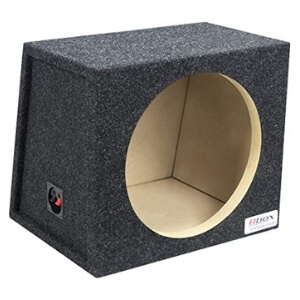
A sealed subwoofer box gives you a tighter, more articulate bass, meaning it’s not as powerful but feels more direct. Don’t be fooled into thinking a sealed box isn’t loud, however, because volume is more about your subwoofer and amplifier. It’s just that a ported box spreads the volume around so it sounds louder.
A bandpass enclosure is kind of a mix of both sealed and ported boxes, but the main difference is that the subwoofer is mounted completely inside the enclosure.
A bandpass sub box consists of a single enclosure with a divider inside, which forms two chambers. One of the chambers is sealed and the other is vented, and this is where the bass is released.
Choosing the right box for your subwoofer depends on the type of bass you’re wanting and your type of music. All enclosures produce great bass if installed correctly and matched with the right subwoofer and amplifier.
If you choose to get everything separately, you really should know the exact sound you’re after and of course the space you have before buying anything.
Choosing The Right Enclosed Subwoofers
You can take all the pain of matching a subwoofer with the box, by getting yourself an enclosed subwoofer, which is an all-in-one package with all the components matched by the manufacturer.
With these types of subs you can get a powered subwoofer, which comes with an inbuilt amplifier, or you can get a passive subwoofer, which is just an enclosed sub. You’ll have to get a separate amp for this.
Because the powered subwoofer has an inbuilt amplifier within the enclosure, the components are a perfect match and it’s by far the easiest and quickest way when installing your new equipment.
And because the amplifier is tucked away in your sub box, it saves on space too. You will have to run a connection from the powered sub to your car battery, because that will power your amplifier. Other than that you just connect it directly to your head unit.
Enclosed powered subwoofers are by far the easiest and usually least expensive option when choosing the right subwoofer for your car.
With an enclosed passive subwoofer, you don’t need to run power to the battery because there’s no amplifier. But of course, you will need to do this when you install your separate car amplifier, which you will need if you’re running a subwoofer.
You can also get vehicle specific subwoofer boxes, that are designed to fit perfectly into a specific vehicle. These look nice nicer and some are molded to match the interior of certain vehicles.
Vehicle specific subwoofers take up less space than your typical subwoofer enclosures, and they’re also more expensive. If space is tight, however, they will save on space, and they take away many of the issues that might arise when installing your subwoofer box.
Best Place To Install Your Subwoofer
Most people put their subwoofer box in their trunk as it’s usually the biggest open space that isn’t taken up by any passengers. And unless you have a family and use the entire trunk regularly, it should be more than enough space.
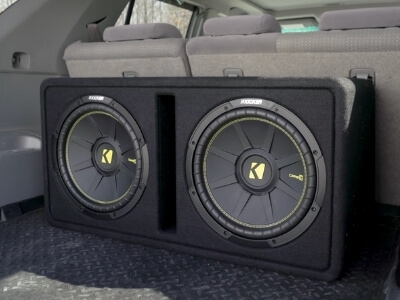
Of course, it all depends on your vehicle. Do you have an SUV or a hatchback? If so, you will likely have plenty of space in your trunk. Or do you have a sporty car, or a pick-up truck where you’re limited for space in the back?
Whatever vehicle type you have will determine the size of sub box you get. Just remember, the bigger the box, the less space you’ll have for groceries and every day life.
If you need the space in your trunk, you can always install a smaller sub box under your seat. These are compact, sealed subwoofer boxes and they will produce nice, accurate, tight bass, and not the booming bass that you will get with a ported box.
Deciding where to install you sub and box it’s all about the space you have and need for other things in life. A car trunk is the most common place, but if you have a pick-up truck or need the trunk for family life, you might have to go for a more compact subwoofer box under or behind a seat.
Choosing The Best Subwoofer For You
With car subwoofers there are many sizes to choose from. 8-inch subwoofers, 10-inch, 12-inch and 15-inch subwoofers are the most common sizes in the car audio space.
When choosing the right subwoofer for your car, remember that the bigger you go, the deeper the sub will be, so you will take up more space.
As long as you get a good quality subwoofer, you will get some resounding bass no matter what size you get. Of course, there are differences in specs, so you should always do research to make sure you’re getting not just the right size sub, but the right brand for your needs.
Check out these reviews on the The Best 10 Inch Subwoofers and The Best 12 Inch Subwoofers. Each review goes in-depth for the best car subwoofers for a variety of tastes and scenarios.
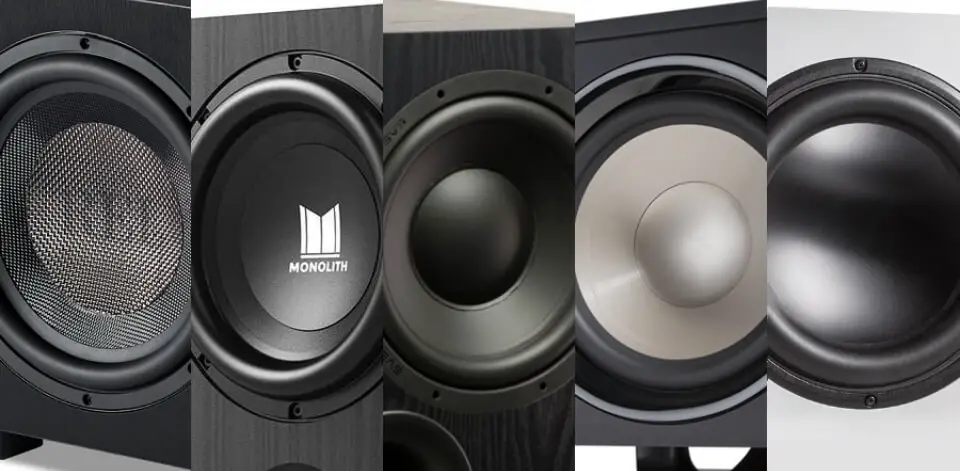
Matching Your Subwoofer With Your Amplifier
If you’re an ‘audionado’ and choose to get your components separately, you’re going to have more variety and arguably a more streamlined sound to your liking.
The first thing you should do is match your prospective subwoofer with an amplifier. Monoblock amplifiers, or subwoofer amplifiers are designed to power subwoofers at around 2 ohms of impedance.
Monoblock amps are mostly Class D amplifiers, which means you’ll be able to blast more bass using less power. But of course if you run your subwoofer from a monoblock, you’ll need another amplifier to run your speakers.
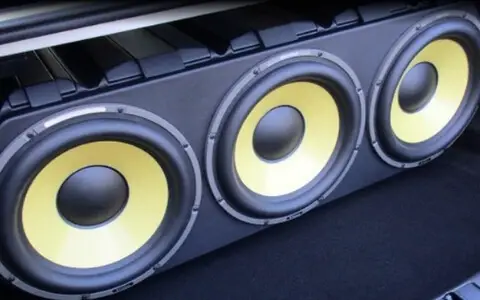
In this case you can always get 4-channel or 5-channel amps. You can get anything from single channel up to 6 channels. There are more, but for a car you shouldn’t need more than 6 channels.
You can get 1 ohm or 4 ohm subwoofers, so whatever impedance your subwoofer is you’ll have to make sure your amplifier can drive subs at the same impedance.
Whatever you do, make sure your amp can power everything that will be driven from it. If it’s just your subwoofer, then fine, but if you get a multi-channel amp, you’ll have to make sure it can power all components.
And depending on the amount of power your speakers need will determine your choice as well. For example, if you’ve got two speakers that can handle 400 watts and they’re 4 ohms each all wired in parallel, you will need an amplifier that can push out 800 watts at 2 ohms.
As always when choosing a car amplifier, you want to know what the sub’s maximum RMS power is, and you need to be within at least ¾ of that power. For example, if your subwoofer can handle 200W, your amplifier should be able to put out at least 150W.
Single vs Dual Subwoofer Voice Coils
Something else you’ll encounter when getting a deciding which subwoofer to get is whether it’s a single (SVC) or double coil (DVC) sub.
The difference is slight but not insignificant: Dual coil subs have a second coil wrapped around the first, which is the component of the speaker that manages the current from the amp.
Both coil systems attach at this junction, but double coil subwoofers have a little bit more adjustability since they can be wired at two different levels of impedance.
Single coils, on the other hand, can only be wired at the prescribed ohm level. As a result, the double-coil setup is a bit more flexible when you’re attaching an amp to the sub.
For example, an amplifier of 1000 watts power will deliver most of its power when connected to a load of 1 ohm, but if it’s connected to a 4-ohm load, it will only deliver quarter of the power.
With a DVC, you can change that same 4-ohm load to either 8 ohms or 2 ohms, which gives you more options. Dual voice coiled subs are slightly more expensive, but they give you more flexibility, especially if you change things up later down the line.
Wiring Your Subwoofer
Getting all the components working means you’re going to have to wire it all up. The best thing to get is a good quality amp wiring kit, which is basically an all in one accessories kit with all the power wires, speaker wires and connectors you’ll need.
Before getting an amp wiring kit, make sure it has the correct gauge wire you’ll need. Every system set up is different, and the wire gauge depends on several different factors, such as how many ohms your amp and sub will power, how long the wires will be etcetera.
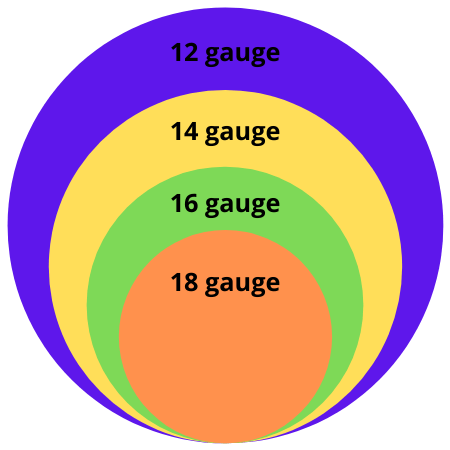
12-gauge wire is the most commonly use wire for subwoofers, but there are some that use 14-gauge or 16-gauge wires. Remember, smaller numbers are thicker wires than the larger numbers. That means 12-gauge wire is much thicker than 16-gauge wire, so if you’re looking for the thickest wire you’d want 12 for a subwoofer.
An amp wiring kit will have enough wire for your installation, but make sure you get the right size. When choosing a wire, it’s better to round up than down in size, because using a 16-gauge wire when you need a 12-gauge wire will result in poor performance from your subwoofer.
Choosing The Right Subwoofer For Your Car Can Be A Complex Decision
Like everything in the car audio world, choosing the right subwoofer for your car is never a straightforward decision.
Getting the right sized subwoofer is probably the easiest part of your decision. They all drive fantastic clear bass, but the size you get usually boils down to how limited you are with space.
10 and 12-inch subwoofers are the most common speakers to get, but size isn’t everything, especially if you just want crisp and clear bass.
Choosing the right enclosure for your subwoofer plays a big role in how your bass is delivered, and of course knowing which one is best for you can be a headache, especially if you’re new to the nuances of bass.
How do you like your bass? If you like it tight and articulate you should get a sealed subwoofer box. If you like your bass spread and loud as possible, go for a ported box or a bandpass box.
If you’re getting all the components separately, you have to match everything up, because if you have a part that doesn’t match, the performance of your sound system will suffer.
For most people getting a powered subwoofer is the easy choice. Manufacturers match everything for you, and they’re usually cheaper than getting everything separately.
Of course, there are limits with many powered speakers compared with putting all the best components together, but it’s barely noticeable if you get a good one.
Getting the right subwoofer for your car isn’t a straightforward decision, but getting it right is so worth it…
Looking For The Best Subwoofers For Your Car:

I am a passionate and skilled car audio enthusiast with 15 years of experience in the industry. My journey started when I replaced my first set of factory car speakers, sparking a deep love for high-quality sound. Since then, I have worked as a representative for renowned brands like Kenwood and Alpine.
With a background in both retail and distribution, I have developed a comprehensive understanding of the car audio market. Currently a certified (MECP) installer in the Mobile Electronics industry, my expertise lies in delivering top-notch audio installations. My knowledge, coupled with my genuine passion, makes me the go-to professional for all car audio needs.


I am replacing a system in my boat. I will be using a fusion head with a fusion SGDA 41400 amp. I have Linn Tukan bookshelf speakers that I enjoy. I don’t have a lot of room for a sub in the cabin; I was thinking of a JL Audio CS110lg-tw1-2 sub. The amp has a low pass and high pass filter. I think this might work, but I don’t understand the OHM set up. The Tukan run at 4ohm and the JL run at 2ohm. Is this going to cause me problems with this set up?
I appreciate any help you can give.
Bob
It will work, but it could cause you problems. I would go for a separate subwoofer amp, if I were you.